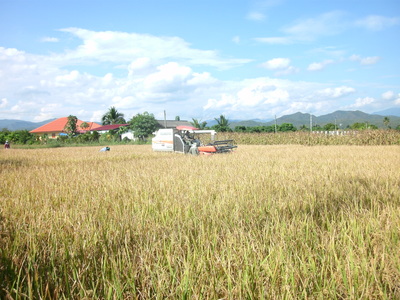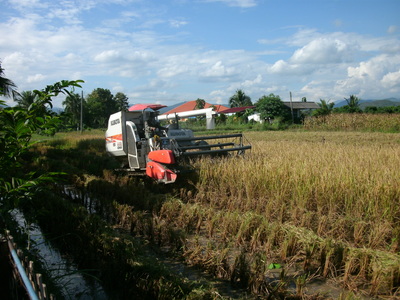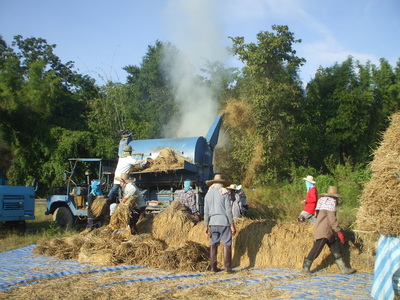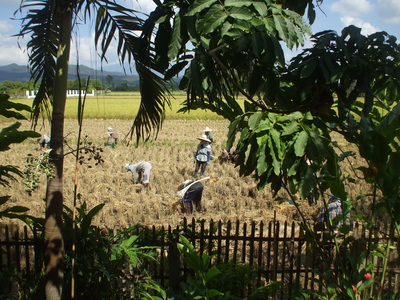|
The culture of village people of North Thailand, no matter which ethnic sub-group, can be called RICE CULTURE. For centuries life has been geared to rice: when it needs to be planted, how it is handled, and what to do in the meantime. That may have already changed. Let’s consider how rice is being harvested this year.
Our rice was harvested today. It was transplanted 105 days ago from seedlings a month old. That’s 4 months total. This year we have two crops from our field. Everybody around here counts on two crops a year. The actual harvesting this year was entirely mechanical for the first time. [See the picture of the rice harvester in action]. It took less than half an hour for our 2 rai [.8 acre]. We can say that rice harvesting requires two separate actions, cutting the plants and threshing the grain. Last year may have been the last time those actions were done separately. As in the past, for a millennium at least, the rice was cut by a work crew [see the picture of the crew cutting the rice by hand]. Getting it done this way is called long khack ลงแขก (literally “descent of guests” [friends, relatives, neighbors] but the phrase is usually used for calling out a work crew for planting or harvesting rice). Work crews were the oldest way of cutting rice. Until recently the grain was separated out of the heads by beating bunches over the lip of a big harvesting basket, on beating it with cudgels on a sun-baked mud floor, or by having hooved animals tread on it. In former times, still within memory, this was a community effort with important social opportunities. Mechanical threshing machines removed a lot of the effort. That’s how our rice was threshed last year and several previous years. It was cut by hand and threshed by machine. This year the harvesting and threshing were done at once. Back home in Illinois the machine that could do both cutting and threshing was called a combine. The next two steps in preparing rice are drying and storing the grain. The final step is to “mill” it, to grind the husk off so it will be ready to cook. This year the rice we just harvested was immediately delivered to an establishment for drying, although it would be cheaper to spread it out in the sun. That takes labor and attention. A sudden downpour of rain can spoil everything. The rice could have been sold today at a price depending on its moisture content and type of rice. But our rice will be kept for the extended family to eat. Essentially every step in the harvesting process this year is being done mechanically for the first time. It could all be done by one laborer with the full range of equipment. But that is too expensive for our limited acreage, or even for a village-size cooperative. The fellow with the combine can harvest a lot of rice in a day, and his window of opportunity is at least two weeks long. A drier can accomplish the task in a few hours. Every village or two gets by with a single mill that can mill a sack of rice in a few minutes. One mill for every 3 or 4 hundred households seems to be enough. The introduction of mechanical equipment has made harvesting less labor intensive. Last year cutting the rice for our 2rai took 10 people about 2 hours. Then the rice was transported by truck to a central threshing operation, which required another couple of hours, with about 15 minutes to feed our shocks into the threshing machine, operated by 4 men.[See the picture above of the threshing machine blowing away the chaff.] Each stage of mechanization reduces the amount of physical labor. This year one man did it all in 30 minutes. It won’t be long until every aspect of rice production will be mechanized. This year we saw a rice transplanting machine for the first time. It was on TV, not yet here in our valley. But even here rice does not have to be transplanted. Seed can be broadcast onto a muddy field under perfect conditions. It’s being done that way more and more in the central part of the country. It’s only a matter of time before we will have planting fully mechanized, too. Life on the farm is no longer rigidly geared to the phases of rice production. Rice for a whole clan of 20 people or so can be planted in a day, left for about 4 months and harvested in a day. Memories will be all that’s left of the year’s major social events when the whole village was busy, when boys met girls, when men courted eligible women around the threshing floor and grew adoring and desperate, and developed life-long friendships. If there is any one thing that shows village culture vanishing, changes in rice harvesting might be it.
0 Comments
Leave a Reply. |
AuthorRev. Dr. Kenneth Dobson posts his weekly reflections on this blog. Archives
March 2024
Categories |
| Ken Dobson's Queer Ruminations from Thailand |
|




 RSS Feed
RSS Feed
